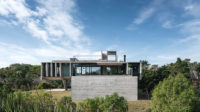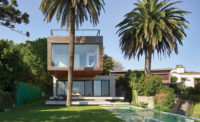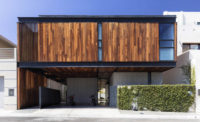Despite its strong rectilinear form, a new house in a Buenos Aires suburb by local architect Luciano Kruk achieves an air of transparency and lightness. Designed for a young couple, the house—an elongated box surrounded by a grove of willow trees and a vast green lawn—is composed of a simple material palette: wood, glass, and concrete. While the concrete “roots the building in time and place,” says Kruk, wood details lend warmth, and generous glazing connects the inside with out.
Along the front facade, Kruk placed vertical fins of lapacho wood planks to provide shade and privacy while maintaining views. Together, the fins—arranged in a rhythmic sequence along the concrete structure—make the house appear as a single rectilinear volume as you approach; the building’s board-formed-concrete walls and black flagstone base seem to disappear into the background. This effect is enhanced by a moat-like rectangular pool that extends from the front facade’s base and spans its entire width, serving as a natural buffer between the front lawn and the entrance, with a concrete bridge to the front door. “The intention,” says Kruk, “was to make the house look as if it is floating above water.”
A straightforward plan allows for possible expansion in the future. It also allows for a functional division of the program. At the central axis point, Kruk cut a square into the roof slab, defining a lush open-air patio that divides the house into two subvolumes, one private—which contains the two bedrooms—and the other social, with the combined living/dining areas and kitchen. In the backyard, Kruk placed a rectangular swimming pool on axis with the inner courtyard, further reinforcing the building’s rigid linearity.
With elements such as water and vegetation incorporated into the design, the house’s precise plan and sharp geometry are softened to “engage the senses,” says Kruk, with boundaries blurred between the interior and exterior living spaces.









Post a comment to this article
Report Abusive Comment